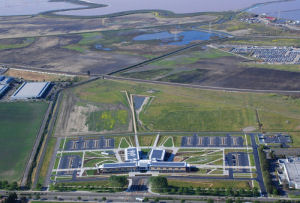Platinum Update: Community College Achives 70 Percent Energy Reduction
 SAN FRANCISCO — Utility records at the LEED Platinum certified Ohlone College Newark Center for Health Sciences and Technology reveal that the campus achieved a nearly 70 percent reduction in gas and electricity consumption during its first year of operation.
SAN FRANCISCO — Utility records at the LEED Platinum certified Ohlone College Newark Center for Health Sciences and Technology reveal that the campus achieved a nearly 70 percent reduction in gas and electricity consumption during its first year of operation.
Since its completion in early 2008, the campus achieved a 69 percent reduction in electricity use and 72 percent reduction in natural gas consumption, compared to a similar facility designed to meet California’s Title 24 requirements. The college also achieved net-zero energy consumption from April to August in 2008.
Planning began in 2003 when Perkins + Will developed a master plan and basic architectural design based on a traditional campus. However, an emphasis was put on sustainable design shortly after Douglas Treadway was named president and district superintendent in July of that year.
“When Dr. Treadway arrived, he put the project on hold so we could determine if the current plan represented the best we could do for our students, community and environment,” says Patrice Birkedahl, Ohlone development director.
The campus now features the largest photovoltaic array in the Silicon Valley, according to planners. Rooftop solar panels cover 35,000 square feet and generate 710 megawatts of power.
HVAC needs are met with a closed ground loop geothermal system that can cool or heat water before it enters the HVAC system. Because the site is located adjacent to federally protect wetlands and the aquifer is shallow, a horizontal bore system was used, instead of the common vertical bore, to prevent contamination.
Two 16-foot diameter enthalpy wheels are used for energy recover when warm indoor air exits the building as exhaust. The system recovers 95 percent of energy lost in traditional buildings, according to planners.
Landscaping at the campus features drought-tolerant plants that require 20 percent to 30 percent less water, compared to other landscaping options. The irrigation also features a weather-monitoring system that calculates evaporation by measuring the temperature and wind.
Many of the building materials and furnishings at the campus are environmentally friendly. Highlights include recycled jean denim for building insulations, low-emission paints and Forest Stewardship Council certified hardwoods.
